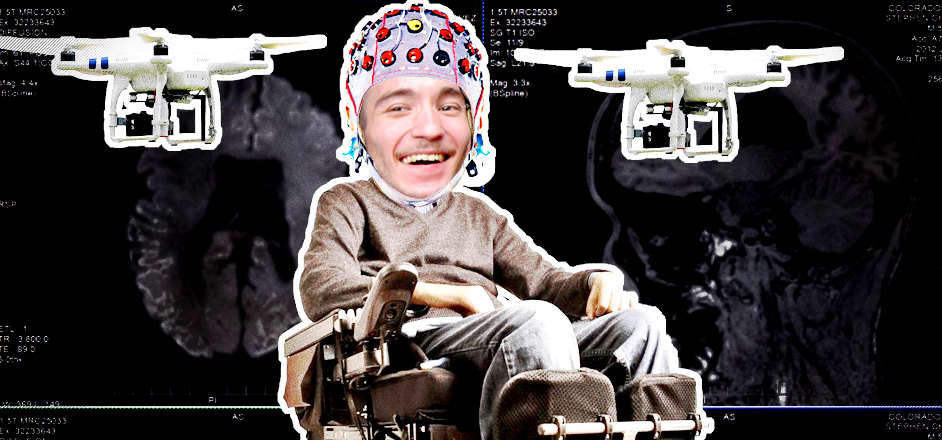When Stephen Chavez first rolled his electric wheelchair toward Boulder Hackerspace — an open garage with motherboards, soldering irons, and mathematical equations on the whiteboards — the engineers fashioned a makeshift ramp to roll him inside. He typed out on his laptop, slow like Stephen Hawking, "Do you guys hack wheelchairs?"
No one in there had any idea the journey they were about to go on.
A couple years have passed since that day, and now his wheelchair hack is helping engineers, tinkerers and dreamers in the lab deal with a big idea: how well can we control machines with our brains?
With only a few thousand dollars from GoFundMe donors, it's possible Chavez, 24, will control his wheelchair with his mind in the near future. Or, one step further, he might be able to engineer wheelchairs to drive themselves. Question is: Will that make him free?
If his wheelchair was self-driving, Chavez jokes with a smile, he could sip Crown and Cokes all night and then instruct his chair to take his drunk ass home.
That's a few years off. For now, he's hacked his wheelchair in ways that Forbes say is "just-plain-sexy" and made The Denver Post call him a "Hotshot Hacker." He's drawing attention from around the world. When Chavez and his research partner Lani Rupp, 23, traveled to China for a convention called GeekPwn, they took home an award.
Rupp says Chavez had Chinese girls "screaming and crying over him."
"He's always got the chicks up on him," Rupp laughs.
In particular, the chicks like that he's run LED lights around his wheelchair, the way suburban kids do with their Honda Civics. Hecontrols them just by typing out a few lines of code in a program called Python on the laptop in front of him.
The biggest hack has to do with a simple human desire: to walk and talk at the same time. See, Chavez "talks" by typing sentences on his laptop using just his left forefinger and thumb. It's slow, but it works. However, if he wants to drive his wheelchair to "walk," he has to use that hand for the joystick. So, he's hooked his wheelchair up to an Xbox controller, allowing for a friend to steer him around while he talks.
Controlling a wheelchair with your mind isn't such a crazy idea. It's often called brain computer interface, or BCI. Sensors in a helmet can read the electrical activity in your head and bridge the gap between brain and tech. It's happening. Netflix bragged that it used an EEG sensor that lets you pick shows with your mind. There's already a telepathic Tesla and a video game you control with your mind. And students recently figured out how you can fly a drone just by thinking.
Colin Fausnaught, 21, at the Rochester Institute of Technology, is trying to make a motorcycle helmet that lets you switch songs on your phone by clenching your jaw. He told us he's working on starting a company that would place sensors on people's bodies so that doctors could diagnose remotely.
The whole awesome subculture of people hooking their brains to their metal has the wonderful, frenetic energy of the early days of computers. No one company or method dominates. It's just folks in garages tinkering with tech. They swap code and tips on discussion groups; the code is usually open source. "We're all just doing it for the greater good," says Rupp, Chavez's partner in hacking his wheelchair, and an expert in computer security herself.
.JPG)
[Chavez and Rupp at the Boulder Hackerspace. Photo by Reilly Capps]
Does this matter at all to the rest of us? Most of us have working limbs and digits. But sometimes you don't. What about when you're skiing, and you want to answer the phone or change the song? Or what if you're so lazy that you don't like moving your thumbs to the Kindle screen to turn the page, or to pick up the phone and order Thai food. It won't be too long before you can slap on a BCI headset and just think: computer, make it so.
Chavez wants to make this work. He was born with schizencephaly; his MRI shows a brain like a donut, missing a huge chunk in the middle. Check it:

[Photo courtesy Stephen Chavez]
When he was born, everyone thought he'd be a vegetable because of it. And while he couldn't talk or walk, the lights were always clearly on, brightly; just last semester, he graduated from Metro State with a degree in computer science and math. He's weighing his job options; Google is said to be interested.
He's even been skydiving.
Chavez and Rupps's GoFundMe drive started just yesterday and is asking for $15,000. They want an Emotiv epoc headset, which reads brainwaves, computer chips and an oscilloscope.
In the Hackerspace, Chavez hands me the Xbox controller, offering me the chance to remote control him. I decline, saying I don't want to be responsible for running him into a wall.
"Won't be the first time I've crashed into shit," he types.
Sort of like the first time he crashed into the Hackerspace, years ago. That was little more than an accident. And look how far he's rolled — in his LED-lit, tricked-out, XBoxed wheelchair — with screaming chicks not too far behind.





Leave a Reply
You must be logged in to post a comment.